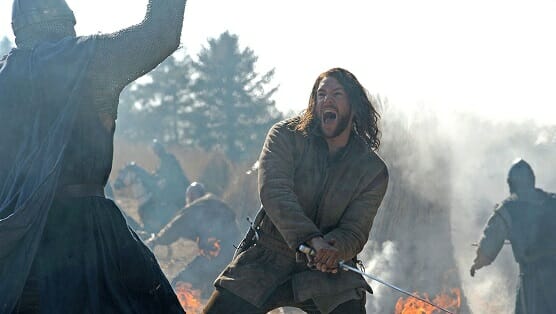
The clash of steel you hear in the two-part pilot for The Bastard Executioner, erstwhile Sons of Anarchy showrunner Kurt Sutter’s new FX passion project, isn’t just the sound of men crossing swords: It’s the sound of Sutter throwing down a gore-stained gauntlet somewhere in the vicinity of George R.R. Martin’s boots. A review of The Bastard Executioner can be contextualized in a number of ways—as historical fiction, as Sutter’s second post-Sons follow-up in 2015 after summer’s Southpaw—but no viewer can escape the blatancy of the show’s impression of HBO’s Game of Thrones. The comparisons are so obvious that it’s hard to tell whether Sutter meant to make a series about England’s brutal dominion over Welsh independence or sword, sorcery, and silliness.
If the latter, then one can hardly blame him. Game of Thrones is such hot fire in ratings terms that every network wants a Game of Thrones of their very own: The CW has the far softer Reign, Starz has Outlander, and Netflix has Marco Polo, a show so incomparably dreadful that it’s amazing anyone thought it deserved a second season renewal. The Bastard Executioner, as FX’s answer to David Benioff’s and D.B. Weiss’ unstoppable masterwork, falls in the middle of the pile of its fellow claimants to Thrones, neither better than the best of them, nor more appalling than the worst. Both halves of its monstrous two hour pilot outing show minor promise when they actually bother telling a story instead of making sheep-shagging jokes.
Where Sutter exceeds his peers is in sheer violence. Thrones catches a lot of criticism for its figurative and literal naked barbarism and sexuality. Applied to Thrones, much of that criticism misses the point. Applied instead to The Bastard Executioner, those critiques have considerably more weight. As medieval fantasy, The Bastard Executioner is almost comically behind the times, an oblivious teenager wearing Jnco Jeans after 1999. Its numerous tropes and cliches are long past the point of being well-worn. As a showcase for graphic human dismemberment, though, The Bastard Executioner often makes Game of Thrones’ assortment of corporal punishments look tame. Take that with however many pinches of salt as you require.
The story takes place in the 14th century, which we know because of helpful expository title cards designed to catch the historically disinclined up to speed. Back in the day, the English did a doozy on all those sharing the lay of the land on their great island, and in dramatized historical narratives, their oppression of Wales and its folk—common and noble alike—is rarely used for plot fodder. But The Bastard Executioner makes a meal of England’s attempts to rule the Welsh, laying out the chain of command from King Edward II to his ruthless barons, who control the population equally through the threat and the exertion of their power. Be taxed, be quiet, or be dead. It’s tyranny 101, really, until a wrench in the works appears in the shape of Wilkin Brattle (Lee Jones).
Brattle, we learn early on, was once a soldier in the king’s army before a near-death experience (visualized by a truly metal dream in which he encounters an angel and a demon in rapid succession) led him to surrender his arms and live the simple life of a Welsh farmer. We see him enjoying this idyll alongside his wife, Petra, heavily pregnant with their first child. If the clear Thrones influences weren’t enough of a tip-off, The Bastard Executioner’s family resemblance to Braveheart clues us in pretty quickly that none of this is to last; as the local baron, Erik Ventris (Brían F. O’Byrne), chokes his subjects with excessive tariffs, Brattle is impelled to battle, running guerilla tactics against Ventris’ men. This, in turn, incurs Ventris’ wrath, and Brattle’s peaceful existence goes up in flames, topped off with a generous helping of mutilated corpses.
It’s all enough to leave Tywin Lannister slack-jawed. At least he waited three seasons to gut an expecting mother. Even the flaying habits of House Bolton are only shown on screen in the past tense. The Bastard Executioner shows that practice in action through the eyes of a torturer-for-hire, a figure who seems superfluous at first but becomes essential in the pilot’s second chapter, which, thanks to a battle that upends our expectations of the show’s hierarchal villainy, is where the show starts gaining momentum. Up until then, it’s all cheesy dialogue coupled with too many character introductions and seriously glacial pacing, though all is admittedly staged with strong production design and captured through the confident direction of Paris Barclay, one of Sutter’s best Sons collaborators. As Part Two commences, we start to get a better idea of where the show is going and who its characters are, though that’s due in part to the fact that a handful of Sutter’s players die in Part One. (Yet another area where he tries to out-Martin Martin: The unpredictability of mortality.)
Of those remaining, there’s Milus Corbett (Stephen Moyer), Erik’s chancellor and the ostensible villain for the season’s remainder; Toran (Sam Spruell) and Berber (Danny Sapani), two of Brattle’s comrades and friends; Baroness Lowry Ventris (Flora Spencer-Longhurst), a native noblewoman and Erik’s wife; and Annora (Katey Sagal), an enigmatic “witch” of Eastern European origins. Most of all, there’s Brattle, who after nearly two hours feels like a blank slate. Mercifully, The Bastard Executioner has a direction to head in after its decidedly uneven pilot wraps up (though if we map Sutter’s influences, its trajectory should be easy to predict), and a terrific premise to build off of. What if a Welshman with nothing to lose became the accidental headman to an English lord? Hopefully the answer proves as interesting as the question.
Boston-based critic Andy Crump has been writing online about film since 2009, and has been scribbling for Paste Magazine since 2013. He also contributes to Screen Rant, Movie Mezzanine, and Badass Digest. You can follow him on Twitter. He is composed of roughly 65% Vermont craft brews.